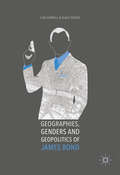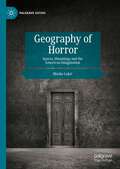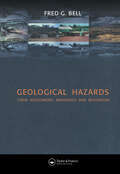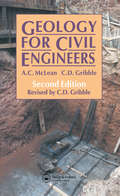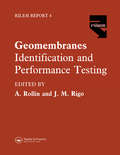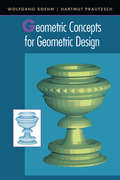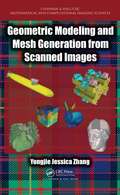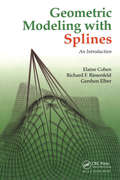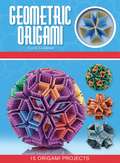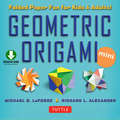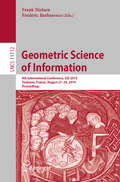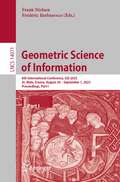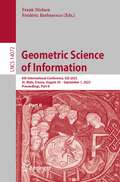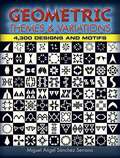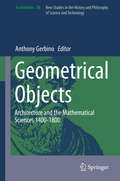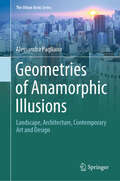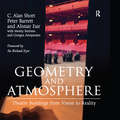- Table View
- List View
Geographies, Genders and Geopolitics of James Bond
by Klaus Dodds Lisa FunnellThis book discusses the representational geographies of the Bond film franchise and how they inform our reading of 007 as a hero. Offering a new and interdisciplinary lens through which the franchise can be analyzed, Funnell and Dodds explore a range of topics that have been largely, if not entirely, overlooked in Bond film scholarship. These topics include: the shifting and gendering of geopolitical relations; the differing depiction and evaluation of vertical/modern and horizontal/pre-modern spaces; the use of classical elements in defining gender, sexuality, heroic competency, and geopolitical conflict; and the ongoing importance of haptics (i. e. touch), kinesics (i. e. movement), and proxemics (i. e. the use of space) in defining the embodied and emotive world of Bond. This book is comprehensive in nature and scope as it discusses all 24 films in the official Bond canon and theorizes about the future direction of the franchise.
Geography of Horror: Spaces, Hauntings and the American Imagination (Palgrave Gothic)
by Marko LukićThis book provides a comprehensive reading of a space/place-based experience from the birth of the American horror genre (nineteenth century American Romanticism) to its rise and evolution in the twentieth and twenty-first centuries. Exploring a series of narratives, this study focuses on the role of space and place as key elements for successful articulation of horror. The analysis, therefore, employs different theoretical premises and concepts belonging to human geography, which, while being part of the larger discipline of geography, predominantly directs its attention towards the presence and activities of humans. By connecting such theoretical readings with the continuously evolving American horror genre, this book offers a unique insight into the academically unexplored trans-disciplinary spatially based reading of the genre.
Geoinformatics in Sustainable Ecosystem and Society: 7th International Conference, GSES 2019, and First International Conference, GeoAI 2019, Guangzhou, China, November 21–25, 2019, Revised Selected Papers (Communications in Computer and Information Science #1228)
by Yong Li Yichun Xie Ji Yang Jianhui Xu Yingbin DengThis book constitutes the refereed proceedings of the 7th International Conference on Geoinformatics in Sustainable Ecosystem and Society, GSES 2019, and First International Conference on Geospatial Artificial Intelligence for Urban Computing, GeoAI 2019, held in Guangzhou, China, in November 2019.The 29 full papers and 3 short papers presented in this volume were carefully reviewed and selected from 80 submissions. The papers are organized according to the following topical sections: the applications of geospatial data in the sustainable development of social economy; new approaches for earth observation data acquisition and processing; remote sensing monitoring of resources and environment and intelligent analysis; intelligent perceptions and services of spatial information; ecology, environment and social sustainable development.
Geological Hazards: Their Assessment, Avoidance and Mitigation
by Fred G. BellNatural hazards cost the global economy over $50,000 million per year. Two thirds of this is spent on damage repair, the remainder represents the cost of predicting, preventing and mitigating against disasters. Man-made hazards such as groundwater pollution, subsidence and soil erosion add to this figure. Geological Hazards presents a state-of-the-art survey and examines methods of assessing, evaluating and combating hazards, both natural and man-made.
Geology for Civil Engineers
by C. Gribble A. McLeanThis seasoned textbook introduces geology for civil engineering students. It covers minerals and rocks, superficial deposits and the distribution of rocks at or below the surface. It then looks at groundwater and gives guidance on the exploration of a site before looking at the civil engineering implications of rocks and the main geological factors which affect typical engineering projects.
Geomembranes - Identification and Performance Testing
by A. Rollin J-M. RigoGeomembranes are increasingly being used in transportation, environmental and geotechnical applications to control gas and liquid movement. This book provides authoritative guidance on testing of geomembranes. It has been prepared by an international committee of experts under the auspices of RILEM, the International Union of Research and Testing L
Geometric Computation: Foundations For Design Applications
by Joy Ko Kyle SteinfeldGeometric Computation: Foundations for Design describes the mathematical and computational concepts that are central to the practical application of design computation in a manner tailored to the visual designer. Uniquely pairing key topics in code and geometry, this book develops the two key faculties required by designers that seek to integrate computation into their creative practice: an understanding of the structure of code in object-oriented programming, and a proficiency in the fundamental geometric constructs that underlie much of the computational media in visual design.
Geometric Concepts for Geometric Design
by Hartmut Prautzsch Wolfgang BoehmThis book is a comprehensive tool both for self-study and for use as a text in classical geometry. It explains the concepts that form the basis for computer-aided geometric design.
Geometric Modeling and Mesh Generation from Scanned Images (Chapman & Hall/CRC Mathematical and Computational Imaging Sciences Series #6)
by Yongjie Jessica ZhangCutting-Edge Techniques to Better Analyze and Predict Complex Physical Phenomena Geometric Modeling and Mesh Generation from Scanned Images shows how to integrate image processing, geometric modeling, and mesh generation with the finite element method (FEM) to solve problems in computational biology, medicine, materials science, and engineering. Based on the author’s recent research and course at Carnegie Mellon University, the text explains the fundamentals of medical imaging, image processing, computational geometry, mesh generation, visualization, and finite element analysis. It also explores novel and advanced applications in computational biology, medicine, materials science, and other engineering areas. One of the first to cover this emerging interdisciplinary field, the book addresses biomedical/material imaging, image processing, geometric modeling and visualization, FEM, and biomedical and engineering applications. It introduces image-mesh-simulation pipelines, reviews numerical methods used in various modules of the pipelines, and discusses several scanning techniques, including ones to probe polycrystalline materials. The book next presents the fundamentals of geometric modeling and computer graphics, geometric objects and transformations, and curves and surfaces as well as two isocontouring methods: marching cubes and dual contouring. It then describes various triangular/tetrahedral and quadrilateral/hexahedral mesh generation techniques. The book also discusses volumetric T-spline modeling for isogeometric analysis (IGA) and introduces some new developments of FEM in recent years with applications.
Geometric Modeling with Splines: An Introduction
by Elaine Cohen Richard F. Riesenfeld Gershon ElberWritten by researchers who have helped found and shape the field, this book is a definitive introduction to geometric modeling. The authors present all of the necessary techniques for curve and surface representations in computer-aided modeling with a focus on how the techniques are used in design.
Geometric Origami
by Richard L. Alexander Michael G. LafosseThis impressive origami ebook contains everything you need to create beautiful, geometric origami sculptures.Art and math intertwine in exciting and complex new ways in Geometric Origami Kit. World renowned origami artists Michael G. LaFosse and Richard L. Alexander bring you this paper craft ebook where folding a piece of paper creates a new and wondrous origami object. In Geometric Origami, the initial folds are easily created, but once the basic building blocks are ready, the intricate combining of these pieces form new geometric origami sculptures that interlock into interchangeable origami puzzles. Ideal for demonstrating the sophistication and wonder of geometry, they can also be great conversation starting decorations for the home or office. This ebook and downloadable material provide the beginning folder with a series of fun, modular origami projects that represent a wide variety of subjects and techniques.This origami ebook includes:Full-color 64-page book Step-by-step instructions and easy-to-follow diagrams Downloadable materialAt a glance, Geometric Origami may seem too difficult to attempt, but once the methods are broken down and explained they are quite simple and can be completed by children and or beginning origami students. The intricate, multi-paper origami sculptures will put your paper folding skills on a whole new level and are excellent for use in the classroom, for art, math or geometry investigations.Origami projects include:Compass Star AsterLightning Bolt OctahedronButterfly BallPicture CubeModular CraneSonobe Module and CubeMagic Rose Cube
Geometric Origami
by Michael Lafosse Richard AlexanderThis compact origami kit contains everything you need to create beautiful, geometric origami sculptures. Art and math intertwine in exciting and complex new ways in Geometric Origami Kit. World renowned origami artists Michael G. LaFosse and Richard L. Alexander bring you this paper craft kit where folding a piece of paper creates a new and wondrous origami object. In Geometric Origami, the initial folds are easily created, but once the basic building blocks are ready, the intricate combining of these pieces form new geometric origami sculptures that interlock into interchangeable origami puzzles. Ideal for demonstrating the sophistication and wonder of geometry, they can also be great conversation starting decorations for the home or office. This kit and DVD provide the beginning folder with a series of fun, modular origami projects that represent a wide variety of subjects and techniques. This origami kit includes: Full-color 32-page book Step-by-step instructions and easy-to-follow diagrams DVD with video tutorial 120 sheets of durable authentic origami paper A variety of different colors At a glance, Geometric Origami may seem too difficult to attempt, but once the methods are broken down and explained they are quite simple and can be completed by children and or beginning origami students. The intricate, multi-paper origami sculptures will put your paper folding skills on a whole new level and are excellent for use in the classroom, for art, math or geometry investigations. Origami projects include: Harlequin Cube Chevron Pinwheel Dazzle Star Hedgehog Dado Stellated Octahedron
Geometric Origami
by Michael Lafosse Richard AlexanderThis impressive origami ebook contains everything you need to create beautiful, geometric origami sculptures. Art and math intertwine in exciting and complex new ways in Geometric Origami Kit. World renowned origami artists Michael G. LaFosse and Richard L. Alexander bring you this paper craft ebook where folding a piece of paper creates a new and wondrous origami object. In Geometric Origami, the initial folds are easily created, but once the basic building blocks are ready, the intricate combining of these pieces form new geometric origami sculptures that interlock into interchangeable origami puzzles. Ideal for demonstrating the sophistication and wonder of geometry, they can also be great conversation starting decorations for the home or office. This ebook and downloadable material provide the beginning folder with a series of fun, modular origami projects that represent a wide variety of subjects and techniques. This origami ebook includes: Full-color 64-page book Step-by-step instructions and easy-to-follow diagrams Downloadable material At a glance, Geometric Origami may seem too difficult to attempt, but once the methods are broken down and explained they are quite simple and can be completed by children and or beginning origami students. The intricate, multi-paper origami sculptures will put your paper folding skills on a whole new level and are excellent for use in the classroom, for art, math or geometry investigations. Origami projects include: Compass Star Aster Lightning Bolt Octahedron Butterfly Ball Picture Cube Modular Crane Sonobe Module and Cube Magic Rose Cube
Geometric Origami (Origami Books)
by Faye GoldmanToo hip to be square, Geometric Origami takes the art of paper folding to stunning new heights.A sophisticated new origami kit for advanced paper-folding enthusiasts, Geometric Origami takes paper art to spectacular new levels. Fifteen intricate paper projects use specially designed strips that come with the book and include a tetrahedron, hexahedron, octahedron, dodecahedron, icosahedron, truncated tetrahedron, cuboctahedron, icosidodecahedron, rhombic triacontahedron, snub dodecahedron, zonohedron, and buckyballs. And don't worry - there are even a few pronounceable shapes like the egg and a geometric bracelet, plus more surprises. This beautifully designed kit gives a new perspective on geometry and the world of origami and is great fun for the entire family - or the perfect gift for a math professor.
Geometric Origami Kit (Idiot's Guides)
by Nick RobinsonIncludes 80 sheets of Origami paper! Idiot's Guides: Geometric Origami Kit makes learning this art easy and fun. For the young or young-at-heart, this full-color book offers 20 beautiful geometric Origami projects and 80 sheets of Origami paper to construct them. In addition, lay-flat spiral binding makes the detailed steps even easier to follow.
Geometric Origami Mini
by Richard L. Alexander Michael G. LafosseThis compact origami ebook contains everything you need to create beautiful, geometric origami sculptures. Art and math intertwine in exciting and complex new ways in Geometric Origami ebook. World renowned origami artists Michael G. LaFosse and Richard L. Alexander bring you this paper craft kit where folding a piece of paper creates a new and wondrous origami object. In Geometric Origami, the initial folds are easily created, but once the basic building blocks are ready, the intricate combining of these pieces form new geometric origami sculptures that interlock into interchangeable origami puzzles. Ideal for demonstrating the sophistication and wonder of geometry, they can also be great conversation starting decorations for the home or office. This ebook and downloadable material provide the beginning folder with a series of fun, modular origami projects that represent a wide variety of subjects and techniques. This origami ebook includes: Full-color 32-page book Step-by-step instructions and easy-to-follow diagrams At a glance, Geometric Origami may seem too difficult to attempt, but once the methods are broken down and explained they are quite simple and can be completed by children and or beginning origami students. The intricate, multi-paper origami sculptures will put your paper folding skills on a whole new level and are excellent for use in the classroom, for art, math or geometry investigations. Origami projects include: Harlequin Cube Chevron Pinwheel Dazzle Star Hedgehog Dado Stellated Octahedron
Geometric Origami Mini
by Richard L. Alexander Michael G. LafosseThis compact origami ebook contains everything you need to create beautiful, geometric origami sculptures.Art and math intertwine in exciting and complex new ways in Geometric Origami ebook. World renowned origami artists Michael G. LaFosse and Richard L. Alexander bring you this paper craft kit where folding a piece of paper creates a new and wondrous origami object. In Geometric Origami, the initial folds are easily created, but once the basic building blocks are ready, the intricate combining of these pieces form new geometric origami sculptures that interlock into interchangeable origami puzzles. Ideal for demonstrating the sophistication and wonder of geometry, they can also be great conversation starting decorations for the home or office. This ebook and downloadable material provide the beginning folder with a series of fun, modular origami projects that represent a wide variety of subjects and techniques.This origami ebook includes:Full-color 32-page book Step-by-step instructions and easy-to-follow diagramsAt a glance, Geometric Origami may seem too difficult to attempt, but once the methods are broken down and explained they are quite simple and can be completed by children and or beginning origami students. The intricate, multi-paper origami sculptures will put your paper folding skills on a whole new level and are excellent for use in the classroom, for art, math or geometry investigations.Origami projects include: Harlequin Cube Chevron Pinwheel Dazzle Star Hedgehog DadoStellated Octahedron
Geometric Science of Information: 4th International Conference, GSI 2019, Toulouse, France, August 27–29, 2019, Proceedings (Lecture Notes in Computer Science #11712)
by Frank Nielsen Frédéric BarbarescoThis book constitutes the proceedings of the 4th International Conference on Geometric Science of Information, GSI 2019, held in Toulouse, France, in August 2019.The 79 full papers presented in this volume were carefully reviewed and selected from 105 submissions. They cover all the main topics and highlights in the domain of geometric science of information, including information geometry manifolds of structured data/information and their advanced applications.
Geometric Science of Information: 6th International Conference, GSI 2023, St. Malo, France, August 30 – September 1, 2023, Proceedings, Part I (Lecture Notes in Computer Science #14071)
by Frank Nielsen Frédéric BarbarescoThis book constitutes the proceedings of the 6th International Conference on Geometric Science of Information, GSI 2023, held in St. Malo, France, during August 30-September 1, 2023. The 125 full papers presented in this volume were carefully reviewed and selected from 161 submissions. They cover all the main topics and highlights in the domain of geometric science of information, including information geometry manifolds of structured data/information and their advanced applications. The papers are organized in the following topics: geometry and machine learning; divergences and computational information geometry; statistics, topology and shape spaces; geometry and mechanics; geometry, learning dynamics and thermodynamics; quantum information geometry; geometry and biological structures; geometry and applications.
Geometric Science of Information: 6th International Conference, GSI 2023, St. Malo, France, August 30 – September 1, 2023, Proceedings, Part II (Lecture Notes in Computer Science #14072)
by Frank Nielsen Frédéric BarbarescoThis book constitutes the proceedings of the 6th International Conference on Geometric Science of Information, GSI 2023, held in St. Malo, France, during August 30-September 1, 2023. The 125 full papers presented in this volume were carefully reviewed and selected from 161 submissions. They cover all the main topics and highlights in the domain of geometric science of information, including information geometry manifolds of structured data/information and their advanced applications. The papers are organized in the following topics: geometry and machine learning; divergences and computational information geometry; statistics, topology and shape spaces; geometry and mechanics; geometry, learning dynamics and thermodynamics; quantum information geometry; geometry and biological structures; geometry and applications.
Geometric Themes and Variations: 4,300 Designs and Motifs (Dover Pictorial Archive)
by Miguel Angel Sánchez SerranoIn this amazing cache of designs, arresting displays of geometrics explode into thousands of fascinating variations. Each of forty-one original black-and-white motifs is spun into three pages of adaptations, offering strikingly different variations on the original theme. More than 4,300 images build upon basic geometric shapes, transforming circles, squares, rectangles, and triangles into intricate patterns that form kaleidoscopic designs, optical illusions, and hypnotic abstracts.A versatile resource for graphics, art, and craft projects, this collection offers not only a wealth of images for immediate practical use but also an excellent reference for design inspiration.
Geometrical Objects
by Anthony GerbinoThis volume explores the mathematical character of architectural practice in diverse pre- and early modern contexts It takes an explicitly interdisciplinary approach, which unites scholarship in early modern architecture with recent work in the history of science, in particular, on the role of practice in the "scientific revolution" As a contribution to architectural history, the volume contextualizes design and construction in terms of contemporary mathematical knowledge, attendant forms of mathematical practice, and relevant social distinctions between the mathematical professions As a contribution to the history of science, the volume presents a series of micro-historical studies that highlight issues of process, materiality, and knowledge production in specific, situated, practical contexts Our approach sees the designer's studio, the stone-yard, the drawing floor, and construction site not merely as places where the architectural object takes shape, but where mathematical knowledge itself is deployed, exchanged, and amplified among various participants in the building process.
Geometries of Anamorphic Illusions: Landscape, Architecture, Contemporary Art and Design (The Urban Book Series)
by Alessandra PaglianoThis book intends to focus exclusively on anamorphic experiments in contemporary art and design, leaving an in-depth historical examination of its Baroque season to other studies. Themes, languages and fields of application of anamorphosis in contemporary culture are critically analyzed to make the reader aware of the communicative potentiality of this kind of geometrical technique. The book also has the aim to teach the reader the most appropriate geometric techniques for each of them, in order to achieve the designed illusion. Each typology of anamorphosis is accompanied in this book by contemporary installations, a geometrical explanation by means of 3D models and didactic experiments carried on in collaboration with the students of the Department of Architecture in Naples.
Geometry and Atmosphere: Theatre Buildings from Vision to Reality
by Peter Barrett C. Alan Short Alistair Fair Monty SutrisnaDrawing on detailed design, construction and financial histories of six prominent Performing Arts buildings with budgets ranging from £3.4 million to over £100 million, Geometry and Atmosphere presents unique and valuable insights into the complex process of building for the arts. Each theatre project, from tailor-made spaces for avant-garde companies to iconic and innovative receiving houses, yields surprising and counter-intuitive findings. For each of the six projects, the authors have interviewed all those involved. Combining these interviews with exhaustive archival research, the authors then provide cross-case analysis which is distilled into guidance for all stakeholders as they transform their initial vision into built reality. In particular, the book challenges the technical focus of existing design guides for the Performing Arts by suggesting that current practice in briefing and design does not serve the Arts community especially well. It shows that there is a need for an approach in which the focus is firmly rooted in the delivery of the driving artistic vision. As well as being of interest to architects, urban designers and those involved in theatre studies, this book will be useful to other sectors where public money is spent on major building projects.
Geometry and Vision: First International Symposium, ISGV 2021, Auckland, New Zealand, January 28-29, 2021, Revised Selected Papers (Communications in Computer and Information Science #1386)
by Wei Qi Yan Minh Nguyen Harvey HoThis book constitutes selected papers from the First International Symposium on Geometry and Vision, ISGV 2021, held in Auckland, New Zealand, in January 2021. Due to the COVID-19 pandemic the conference was held in partially virtual format. The 29 papers were thoroughly reviewed and selected from 50 submissions. They cover topics in areas of digital geometry, graphics, image and video technologies, computer vision, and multimedia technologies.
